In the 70s and 80s Essex of my youth, no one had a real Christmas tree unless they lived in the country, or perhaps Loughton. Our family’s skinny artificial tree is now 54 years old and still comes out every year at my sister’s. It’s shed a few plastic “needles” down the years, but it’s still standing proud – which is more than you can say for a real Christmas tree bought in 1971, or even 2024.
Therein lies the surprising environmental efficiency of artificial Christmas trees. The Carbon Trust says using a fake tree over seven to 20 years (depending on its weight and materials) can create fewer emissions than buying a new, commercially grown tree every year. The key is to buy an artificial tree you’ll love enough to roll out for decades.
To help you choose your forever tree, I rounded up a veritable forest of the best fake Christmas trees, including pre-lit, frosted and mini models. Along with my husband, Alan, I compared them on factors including appearance, durability and whether they could be assembled without causing a breakdown in domestic relations. I also attempted a few on my own to see how easy they were to put up without help.
Here I reveal which trees made Christmas come early, and which ones drove us straight to the mini liqueurs.
At a glance
-
Best Christmas tree overall:
Habitat mixed-tip upswept
-
Best budget Christmas tree:
Robert Dyas Alaskan pine with LEDs
-
Best realistic Christmas tree:
Christmas Tree World Matterhorn pine
-
Best space-saving Christmas tree:
Homcom pencil slim
Why you should trust me
I’ve spent three decades reviewing products, from smartphones to mattresses, so I’m professionally sceptical of manufacturers’ claims to magically improve our lives by buying their stuff. I also have a solid background in hay fever and cats, both of which are triggered by having a real tree in the house, so I’m on a mission to find the best, greenest and safest alternative.
How I tested

Artificial Christmas trees vary in many factors other than height. Foliage style, material, width, number of tips and method of assembly are important considerations when buying, but brands don’t always reveal these specs. My testing, then, involved a lot more measuring and tip counting than anticipated.
To keep things simple, I requested the 6ft model of every full-size tree on my shortlist, all sourced from manufacturers and retailers. Taller trees tend to be correspondingly wider, and there was no way I’d fit a forest of 8ft trees in my house (or indeed reach them). I awarded kudos for the range of sizes available, though.
While height in feet is the one specification you’re guaranteed to get when buying a tree, I learned not to take it too literally. My “6ft” trees varied in height from 180cm (actually 5ft 11) to 183cm (just over 6ft).
My lawfully wedded testing partner, Alan, helped me put up most of the trees one weekend. I also assembled a few on my own, including the largest and heaviest, to see whether they’d be too much trouble for someone living alone.
We timed how long it took to unbox each one, assemble it and arrange its foliage. We looked for clearly marked sections that slotted easily but securely together, sturdy stands, strong, flexible branches that were easy to separate and position, and clear instructions.
After measuring each tree, counting its tips and pausing for a much-needed mince pie, we gave them all a good shake. Fake plastic trees shed needles, too. Not nearly as many as a real tree, but some – including our own budget Lidl tree – are litter bugs, screeding the floor with tiny plastic strips. Minimal shedding is a good sign of a tree’s build quality and durability.

Next, we loaded each full-size tree with decorations to see if the branches drooped or baubles slid off. The smaller trees were subjected to less festive baggage, but we crowned each one with a 150g homemade tree-topper to see how well its vertical top branch remained standing, if at all.
Pre-lit trees save time when assembling, provided they have a good number of lights arranged evenly and attractively. However, there’s no point in spending more on a pre-lit tree (usually about £15 extra for a full-size model) if you have to spend time rearranging or embellishing it with additional lights. With these models, we also looked for well-concealed cables that didn’t get in the way of assembling the tree, plus easy-to-connect sections and a long mains cable.
Finally, we took each tree apart again and tried to squeeze them back into their boxes, with mixed success. They were collected by Southampton hardship charity Scratch, which will distribute them to families in need this Christmas.
The best artificial Christmas trees you can buy in 2025

Best Christmas tree overall:
Habitat mixed-tip upswept
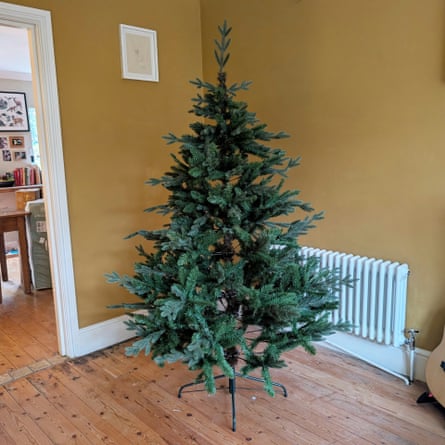
This beautiful tree uses a realistic silhouette and a mix of foliage materials to create a classy, textured look. It made a strong statement in the corner of our living room before we’d even added a bauble.
Why we love it
Habitat’s magnificent Alpine fir lookalike was one of the easiest trees in my test to put together. Its three clearly marked sections slotted together easily, and the metal-hinged branches dropped effortlessly into place. This is one of several trees I tried assembling on my own, and I was pleasantly surprised by how quick and painless I found it – once unboxed, it took six minutes to get to a basic tree shape. It’s quite heavy when assembled, though, so I’d recommend building it in the spot you want it to stand for the next few weeks.
This tree can be as bushy as you choose. If you prefer your festive topiary on the dense side, you can go to town sculpting the wired branch tips until there’s little space between them. If you’d rather have plenty of room to hang decorations, leave the branches as they are and fill the gaps with dangly doodads.
As with most artificial Christmas trees, this one is “upswept”, which means the tips point upwards and can double as hooks for decorations. The branches supported ornaments well, and the top branch was strong enough to stand proud when adorned with my 150g topper.
Most of the fake foliage on this tree is your standard AstroTurf-style slivers of green plastic, but thoughtful details set it apart. Each batch of fluffy fronds has a coniferous shape with shorter blades at the end, and several of the tips are rubbery PVC in a different shade of green to create a natural look. No bits fell to the floor, even when we gave the tree a good wobble.
It’s a shame that … the gorgeously wide sweep of the lower branches means you’ll need a fairly spacious room to put it in. You’ll have loads of room for presents underneath, though.
Dimensions (6ft version): 183cm tall by 117.5cm at widest point
Branch tips: 1,951
Lights: none
Other heights available: 5ft, 7ft, 8ft
Foliage material: PVC
Best budget Christmas tree:
Robert Dyas Alaskan pine with LEDs
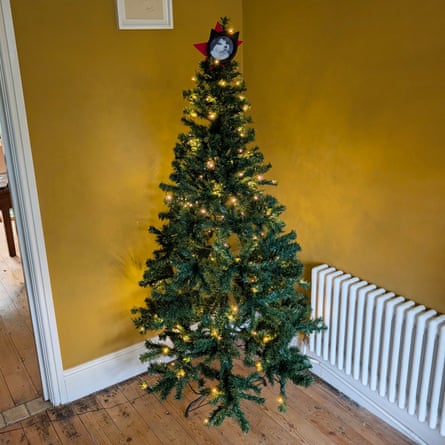
A good-value buy isn’t just cheap, but built to last. Despite costing less than £50 (or £34.99 for the unlit version), this richly coloured tree is conveniently pre-lit and robust enough to survive several years of use.
Why we love it
Budget Christmas trees used to be sorry affairs, all droopy neon plastic with bald bits. Not any more, judging by two of the cheapest trees in my test. The Robert Dyas isn’t quite as bushy as the Homcom tree mentioned below, but once you fluff up its plentiful branch tips, it’s an impressively verdant pyramid. Plug in the pre-adorned lights, and it’s showy enough to need few further embellishments.
The lights are a simple affair. Each of the tree’s three sections has a string of LEDs with cable connectors, and the resulting combined string is mains-powered, so you don’t have to worry about batteries. It’s quick to put together and saves an awful lot of time and fairy-light-based hassle.
There are no display options, such as flashing or colours, but the warm white light is a cosy choice. My experience with similar lights suggests these may only last a few years, but the tree itself is sturdy enough to survive many a Christmas and not just end up in landfill.
It’s a shame that … it’s not as natural-looking as the Habitat tree and sheds a few fake needles, although far fewer than a real tree.
Dimensions (6ft version): 180cm tall by about 90cm at widest point
Branch tips: we counted about 550
Lights: we counted about 120 LEDs
Other heights available: 4ft
Foliage material: PVC
Best realistic Christmas tree:
Christmas Tree World Matterhorn pine

The dark green foliage of this gloriously lifelike pine will have your neighbours and visitors doing a double take. Its needles feel rather realistic, too, so it’s just as well that you get a pair of protective gloves in the box.
Why we love it
When I read “PVC”, I tend to think of shiny black pleather, but the dense PVC needles of this artificial pine tree are more like wire. It makes the branches feel a bit like bottle brushes, so you wouldn’t want to sit around stroking them, but I concede that Christmas trees are made to look at rather than fondle – and this one is a serious looker.
Initial assembly was really quick, but plumping its strong branch tips to their fullest took us a while. Every one of the nearly 900 tips is adjustable and strong enough to support multiple decorations, and if you’re patient, the end result is spectacular.
The Matterhorn is the heaviest and most robust of all the trees I tested. It comes with a 10-year guarantee, but I expect it will last much longer. As Christmas Tree World says in its excellent instruction booklet, this is far from being single-use plastic. I could even see it being passed down generations. Just don’t be tempted to put it outside because the steel hinges will rust.
It’s a shame that … the foliage is darker than your average bright green fake tree. My husband adored it but I found it a little too dark, needing plenty of decorations to look camp enough for Christmas.
Dimensions (6ft version): 180cm tall by 110cm at widest point
Branch tips: 856
Lights: none
Other heights available: 5ft, 7ft, 8ft; plus pre-lit
Foliage material: PVC

I was happy to break my 6ft-max rule for this 6ft 5in tree because its slim silhouette (54cm at its widest) means it hogs little space in the faux forest that’s taken over my living room. Its height and dense foliage make it a real standout.
Why we love it
Homcom’s tree is far more than just a standard tree with shorter branches. Real thought has gone into packing plenty of interest into its slim frame. The greenery is unusually varied, with some tips boasting long fronds and light frosting that make them look like festive dandelion clocks. My favourite feature was the 27 artificial pine cones, each attached using bendy wire so you can adjust them to your liking.
This tree is a winner on practicality. It was the quickest and easiest tall tree to put together; its branches needed relatively little shaping, and even a short person like me found it light and easy to move around the room.
It’s a shame that … the short, bushy branches don’t leave much room for decorations, but honestly this tree doesn’t really need them – maybe just a star at the top. Also be aware that its 195cm height is actually 6ft 4.8in, not six and a half feet.
Dimensions (6ft 5in version): 195cm tall by 54cm at widest point
Branch tips: 556
Lights: none
Other heights available: 5.5ft
Foliage material: PVC
after newsletter promotion
The best of the rest
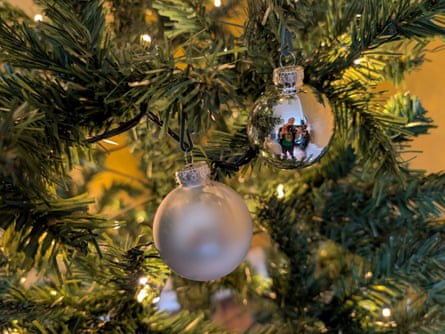
Arboretum Nordmann fir pre-lit potted tree

Best for: adding chic sparkle to your garden, balcony or front step
Pre-lit trees are generally for indoor use only, but this stylish and realistic 3ft fir can go outdoors too. Its lights are powered via a sealed battery pack designed to withstand the elements, and the greenery is a weatherproof, rubbery plastic.
Each branch is posable and quite long – this is a wide tree rather than a tall one. It comes firmly embedded in a high-quality pot, so you can pick up the whole thing by the tip without sending the pot crashing to the ground.
You don’t even have to remember to switch off the lights. Once on, they’ll stay lit for six hours before automatically switching off – and then come on again at the same start time the next day.
It didn’t make the final cut because … the light strings got tangled in the branches, so assembling this tree was more trouble than its 3ft size warranted. You also have to supply your own batteries.
Dimensions (3ft version): 90cm tall by 86cm at widest point; tips: about 200; lights: 50 warm white LEDs; other heights: none; foliage material: PVC and polyethylene
Dunelm snowy blue spruce

Best for: an indoor white Christmas
This tree is not just lightly dusted with fake snow: it’s drenched in the stuff, like you’ve dipped it in glue then rolled it down an Alp. This makes its branches much thicker, and we found it hard to hang many baubles without making it look overdone, but at least that means it doesn’t need much work. String it with fairy lights or even just a topper, and it’s good to go.
Underneath the frosting is a decent mid-range tree with a mix of tip types, not unlike the Habitat. We found it easy to assemble, and its metal stand is unusually sturdy. The best snowy tree I tested.
It’s a shame that … the fake snow (which is unlikely to enhance this tree’s sustainability credentials) litters the floor in what looks like the dandruff of a giant.
Dimensions (6ft version): 180cm tall by 106cm at widest point; tips: we counted about 700; lights: none; other heights: 7ft; foliage material: plastic
Aldi snowy Christmas tree

Best for: a budget frosted tree that doesn’t look cheap
Aldi’s tree comes in a green or snowy version, both just under 6ft. I was sent the snowy version, which had the same dandruff as the Dunelm, but comes with by far the most impressive stand of all the trees I tested – a wooden cross that took us far too long to screw into place using the supplied nuts and washers. Once done, the stand looked fantastic and gave the tree a solidity that made it fairly easy to move around.
This tree has a relatively high number of branches according to Aldi’s count, but they don’t look quite as dense as those of the Dunelm tree, and we found them easier to separate and position.
It’s a shame that … you can’t buy Aldi’s tree online, only in store – and at this superb price it’s likely to sell out fast.
Dimensions: 180cm tall by 108cm at widest point; tips: 972; lights: none; other heights: none; foliage material: polyethylene
Robert Dyas Westbury multicolour fibre optic

Best for: anyone for whom “too much” is never enough at Christmas
The Westbury (or Woodbury, on the box) is the smallest tree I tested, but has the biggest kitsch appeal by far. After minimal adjustment of the fluffy branches, we plugged the tree into the mains and it threw out so much light and colour that we squealed like excited children.
The tree was a breeze to assemble, without even a cable to get in the way, because the fairy lights and fibre-optic filaments are firmly embedded in the branch tips. Its handy remote control is ready to go out of the box, so we immediately set about changing colours, playing with effects and testing the timer.
It didn’t make the final cut because … £50 is a lot to spend on a fun novelty choice that’s unlikely to be your main tree for years to come. Shame it’s not more securely attached to the pot, either.
Dimensions (3ft version): 90cm tall by 20cm at widest point; tips: we counted about 250; lights: 80 fibre optic tips and approx 80 LEDs; other heights: none; material: plastic
Christmas Tree World pre-lit ultra pop up
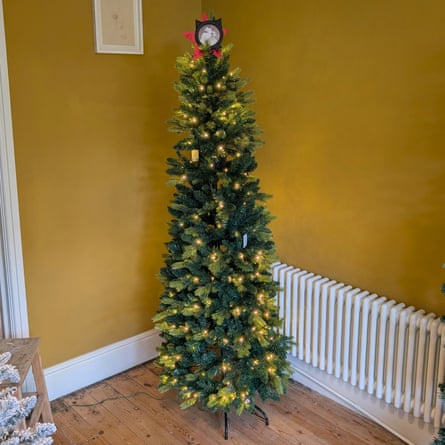
Best for: going from zero to fully lit tree in seconds before guests arrive
This one’s quicker to prepare than eggnog. Open the box and lift out the tree – like a big green crinoline skirt with branches and fairy lights attached – then prop it on to its central pole, switch on the lights, et voilà: your tree.
It’s an absolute cracker, too. There’s plenty of room for decorations, but the mix of green shades gives the bendable tips a dense, textured look that means you can get away with a minimal scattering of baubles.
It didn’t make the final cut because … it’s expensive for what you get, and the uniformly triangular shape of the tree means no one would mistake it for the real thing.
Dimensions (6ft version): 180cm tall by 60cm at widest point; tips: 686; lights: 200 warm white LEDs; other heights: 7ft; foliage material: PVC and polyethylene
Robert Dyas Duchess slim pre-lit

Best for: anyone short on time and space
I expected this tree to be little more than a slimmed-down version of the cheaper Robert Dyas Alaskan pine. It’s much bushier, though, and its lights feel more securely attached, giving it a more durable feel.
The branches are thickly adorned with deep green plastic foliage, giving a denser look than most other trees I tested – even before you’ve spent time adjusting all the tips. At 75cm wide, it’s big enough to look impressive but small enough to suit smaller living spaces.
It didn’t make the final cut because … the thick foliage looks great, but it doesn’t leave much room for decorations.
Dimensions (5ft version): 150cm tall by 75cm at widest point; tips: 327; lights: 150; other heights: none; material: plastic
What you need to know

Can an artificial Christmas tree really be more sustainable than a real one?
You mean, is a 7ft pyramid of plastic more environmentally friendly than an actual tree? Obviously not. Even if you retire a real tree by setting fire to it – a process not exactly short on pollutants and greenhouse gases – it’s still a greener choice in the short term. “An artificial tree has 10 times the carbon footprint of a natural tree that’s burned after Christmas,” says Alex Robinson, CEO of UK environmental charity Hubbub.
An artificial tree is not just for one Christmas, however. “As long as an artificial tree is reused for 10 years or more, its environmental impact will balance out,” says Robinson. This backs up the Carbon Trust’s finding that a fake tree used for seven to 20 years, depending on its weight and materials, produces fewer emissions than buying a new, commercially grown tree each year.
Real and fake trees have their environmental pros and cons, says Tristan Sissons, head of purchasing at Hillier Nurseries. “Real trees are biodegradable, and they’re grown for years before they’re sold, absorbing carbon dioxide from the air as they grow. But artificial trees can be used for years, so they avoid the ‘one use and dispose of’ mentality.”
The best artificial Christmas trees are investment pieces that cut landfill – you would hope. “Sadly, it’s estimated that artificial Christmas trees are used on average only four times, so it’s important to buy one that gets used year after year,” says Robinson.
You don’t have to wheel out the same tree for 54 years like my family, but a decade or more is easily achieved if you choose wisely. All the trees I mention above are robust enough to last 10 years or more, and a few – notably the Habitat and the Christmas Tree World Matterhorn pine, which comes with a 10-year guarantee – are so well built that they probably have a longer life expectancy than I do.
How else can I minimise my tree’s carbon impact?
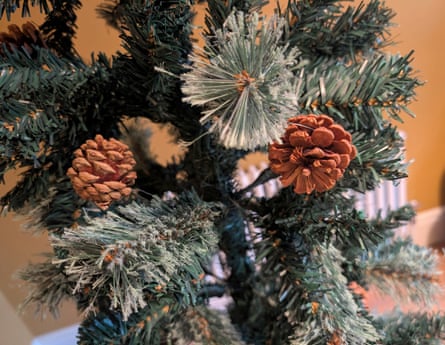
Flocked trees are trending in 2025, according to retailers including Christmas Tree World and Wayfair, but the fake snow they’re covered in makes your tree less green in more ways than one. A flocked tree can still have a smaller carbon footprint than an annual series of real trees, though, if you use it every year for long enough. According to the UK environmental organisation 100Green, artificial flocking increases the carbon break-even time for an artificial tree to 15 years, and if you spray it on a real tree it’ll render the tree non-recyclable. It also makes a mess on the floor, albeit more manageable than real tree needles.
Pre-lit trees have their green drawbacks, too. LED strings are unlikely to have as long a lifespan as a fake tree, and they’re often attached so securely to pre-lit trees that they can be a hassle to replace.
The most frustrating environmental aspect of artificial Christmas trees, though, is where they’re made: China, almost without exception. Not a single tree I was able to source was made in the UK, including those, such as the Atkin and Thyme Nordmann fir, whose brands put a homegrown vibe at the centre of their appeal. I’m now redoubling efforts to find UK-made trees to add to this roundup in plenty of time for Christmas.
Jane Hoskyn is a features journalist and WFH pioneer with three decades of experience in rearranging bookshelves and “testing” coffee machines while deadlines loom. Her work has made her a low-key expert in all manner of consumables, from sports watches to solar panels. She would always rather be in the woods, but at least this article let her bring the woods into her home

 3 hours ago
6
3 hours ago
6

















































